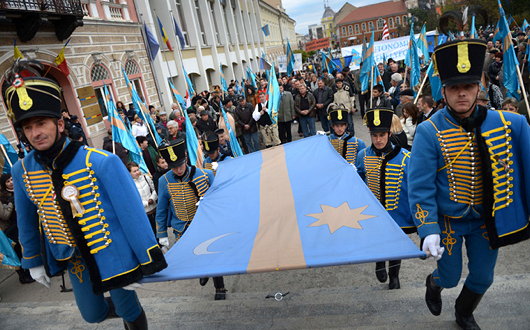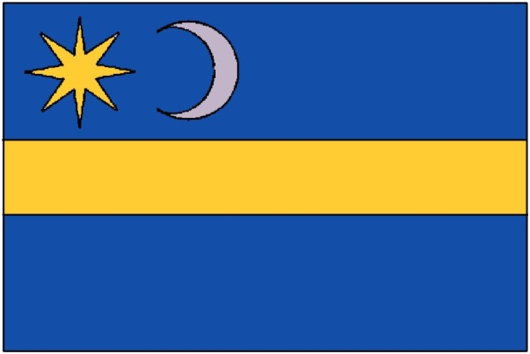
About Andrew Cusack
 Writer, web designer, etc.; born in New York; educated in Argentina, Scotland, and South Africa; now based in London.
Writer, web designer, etc.; born in New York; educated in Argentina, Scotland, and South Africa; now based in London. read more
News
Blogs
Reviews & Periodicals
Arts & Design
World
France
Mitteleuropa
Knickerbockers
Argentina
The Levant
Africa
Cape of Good Hope
Netherlands
Scandinavia
Québec
India
Muscovy
Germany
Academica
Squabbles Over Szekler Flag

In Transylvania, a “flag war” has broken out between Romanian politicians and the representatives of the Hungarian-speaking Szekler people. As România Libera reports, no one is offended by flying the old Hapsburg flag over the fortress of Alba Iulia (De: Karlsburg, Hu: Gyulafehérvár), the Romanian government takes umbrage at the appearance of the blue-and-gold flag of the Szekler (or Székely) people who live primarily in three of Transylvania’s counties.
“Romanian leaders never miss an opportunity to annoy the Székelys, Romania’s Hungarian minority.” The flag war “waged by the central government and a number of Transylvanian regional municipalities is only the latest episode in Bucharest’s campaign to create tensions with the Hungarians”.
The Szeklers are one of the numerous smaller ethnic groups left adrift by the collapse of the Austro-Hungarian empire. At the end of the First World War, the enlarged Romanian kingdom inherited provinces with sizable Hungarian populations, often in the majority. There remain to this day several German towns and villages in Romania, and 2007 European Capital of Culture Hermannstadt (Ro: Sibiu, Hu: Nagyszeben) is politically dominated by ethnic Germans freely elected by the Romanian majority.
As the New York Times reported in 2008, the success of the ethnic Albanian majority in the Serbian province of Kosovo has given hope to Szeklers that they might win greater autonomy for the Terra Siculorum: the Szekler-majority counties of Harghita and Covasna along with those parts of Mures county where the Szeklers are dominant.
Is this a nationalist struggle of the Szeklers, or a Szekler reaction to the stultifying hand of Romanian nationalism? Perhaps six of one, half-dozen of the others. The tendency (forged in the late nineteenth century) to prefer united ethnically monotonous states is a modern one of which we disapprove. The dissolution of Austria-Hungary is a disaster from which Europe has not yet recovered, as the Szeklers know well.

Search
Instagram: @andcusack
Click here for my Instagram photos.Most Recent Posts
- Faithful Shepherd of the Falklands April 8, 2025
- Articles of Note: 8 April 2025 April 8, 2025
- Proportionality Destroys Representation April 8, 2025
- Sag Harbor Cinema March 26, 2025
- Teutonic Takeover March 10, 2025
Most Recent Comments
Book Wishlist
Monthly Archives
Categories



They are a very interesting minority. They were historically unitarian and continued to use a rune alphabet until the eighteenth century.
Dear Andrew,
Thank you for another interesting article.
The cartoon flag is rather distinct from that carried by the Hussars
in the photo. Do you know why?
(By the way, as a fan of the Hapsburg monarchy, you may be interested in
the Black-Gold alliance: http://sga.monarchisten.org/mitteleuropa.html )
Best to you,
Paddy